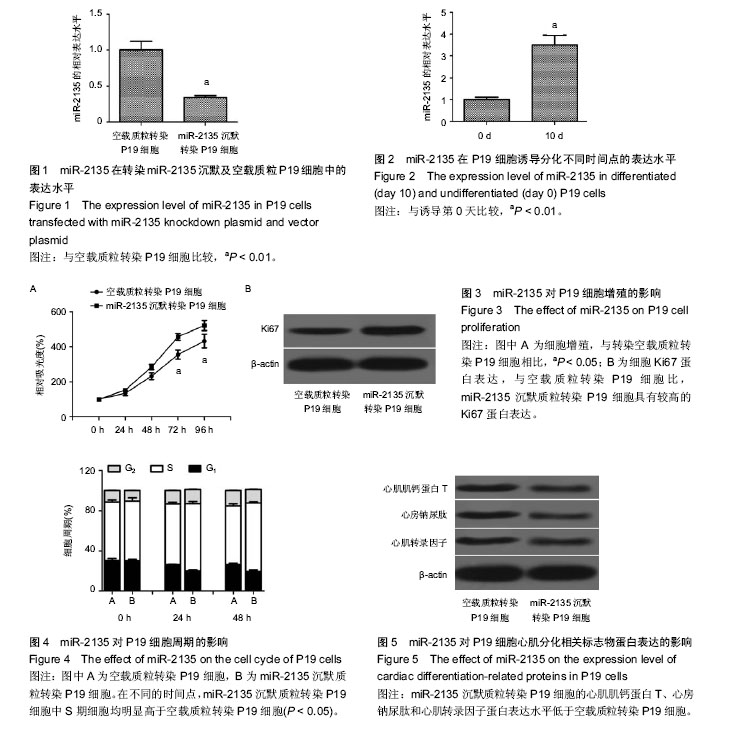| [1] Zaffran S,Frasch M.Early signals in cardiac development.Circ Res.2002; 91(6):457-469.
[2] 王春梅,姜涛,周春燕.诱导心脏发生的早期信号通路[J].中国生物化学与分子生物学报, 2004,20(5):572-577.
[3] Miyazono K,Kamiya Y,Morikawa M.Bone morphogenetic protein receptors and signal transduction. J Biochem.2010;147(1):35-51.
[4] Bajolle F,Zaffran S,Bonnet D.Genetics and embryological mechanisms of congenital heart diseases.Arch Cardiovasc Dis.2009;102(1):59-63.
[5] Kajstura J,Rota M,Cappetta D,et al.Cardiomyogenesis in the aging and failing human heart. Circulation. 2012; 126(15):1869-1881.
[6] Aguilar JS,Begum AN,Alvarez J,et al.Directed cardiomyogenesis of human pluripotent stem cells by modulating Wnt/β-catenin and BMP signalling with small molecules. Biochem J.2015;469(2):235-241.
[7] Müller M,Stockmann M,Malan D,et al.Ca2+ activated K channels-new tools to induce cardiac commitment from pluripotent stem cells in mice and men.Stem Cell Rev.2012;8(3):720-740.
[8] Zhao Y,Ransom JF,Li A,et al.Dysregulation of cardiogenesis, cardiac conduction, and cell cycle in mice lacking miRNA-1-2.Cell.2007;129(2):303-317.
[9] Morton SU,Scherz PJ,Cordes KR,et al.microRNA-138 modulates cardiac patterning during embryonic development.PNAS.2008;105(46):17830-17835.
[10] Qin DN,Qian L,Hu DL,et al.Effects of miR-19b overexpression on proliferation, differentiation, apoptosis and Wnt/β-catenin signaling pathway in P19 cell model of cardiac differentiation in vitro. Cell Biochem Biophys.2013;66(3):709-722.
[11] Hoffman JI,Kaplan S.The incidence of congenital heart disease.J Am Coll Cardiol.2002;39(12):1890-1900.
[12] Yutzey KE,Colbert M,Robbins J.Ras-related signaling pathways in valve development: ebb and flow. Physiology. 2005;20(6):390-397.
[13] Bruneau BG.The developmental genetics of congenital heart disease.Nature.2008; 451(7181):943-948.
[14] Olson EN.Gene regulatory networks in the evolution and development of the heart. Science. 2006; 313 (5795):1922-1927.
[15] van der Heyden MA,Defize LH.Twenty one years of P19 cells: what an embryonal carcinoma cell line taught us about cardiomyocyte differentiation. Cardiovasc Res.2003;58(2):292-302.
[16] van der Heyden MA,van Kempen MJ,Tsuji Y,et al. P19 embryonal carcinoma cells: a suitable model system for cardiac electrophysiological differentiation at the molecular and functional level.Cardiovasc Res. 2003; 58(2):410-422.
[17] 万楠,刘培燕,邱广蓉,等.miR-324-5p 在先天性心脏病患者血浆中的表达[C].第十二次全国医学遗传学学术会议论文汇编,2014.
[18] 夏曦.儿童先天性心脏病心力衰竭与血清 miR-30a水平的关系[J].临床儿科杂志,2014, 32(7):607.
[19] Sluijter JP,van Mil A,van Vliet P,et al.MicroRNA-1 and-499 regulate differentiation and proliferation in human-derived cardiomyocyte progenitor cells.Arterioscler Thromb Vasc Biol.2010;30(4):859- 868.
[20] Cheng Y,Ji R,Yue J,et al.MicroRNAs are aberrantly expressed in hypertrophic heart: do they play a role in cardiac hypertrophy? Am J Pathol.2007;170(6): 1831-1840.
[21] Ventura A,Young AG,Winslow MM,et al.Targeted deletion reveals essential and overlapping functions of the miR-17∼ 92 family of miRNA clusters.Cell.2008; 132(5):875-886.
[22] Li Q,Song XW,Zou J,et al.Attenuation of microRNA-1 derepresses the cytoskeleton regulatory protein twinfilin-1 to provoke cardiac hypertrophy.J Cell Sci. 2010;123(14):2444-2452.
[23] Wong S,Ritner C,Ramachandran S,et al.miR-125b promotes early germ layer specification through Lin28/let-7d and preferential differentiation of mesoderm in human embryonic stem cells.PLoS One.2012;7(4):e36121.
[24] Li X,Wang J,Jia Z,et al.MiR-499 regulates cell proliferation and apoptosis during late-stage cardiac differentiation via Sox6 and cyclin D1.PLoS One. 2013;8(9):e74504.
[25] Rajala K,Pekkanen-Mattila M,Aalto-Setälä K.Cardiac differentiation of pluripotent stem cells.Stem Cells Int. 2011;2011:383709.
[26] Yao CX,Wei QX,Zhang YY,et al.miR-200b targets GATA-4 during cell growth and differentiation.RNA Biol.2013;10(4):465-480.
[27] Knezevic I,Patel A,Sundaresan NR,et al.A novel cardiomyocyte-enriched MicroRNA, miR-378, targets insulin-like growth factor 1 receptor implications in postnatal cardiac remodeling and cell survival.J Biol Chem.2012;287(16):12913-12926.
[28] Clément T,Salone V,Rederstorff M.Dual Luciferase Gene Reporter Assays to Study miRNA Function.Methods Mol Biol. 2015;1296:187-198.
[29] Meng J,Shi GL,Luan YS.Plant miRNA function prediction based on functional similarity network and transductive multi-label classification algorithm. Neurocomputing.2015;179:283-289.
[30] Enlund E,Fischer S,Handrick R,et al.Establishment of Lipofection for Studying miRNA Function in Human Adipocytes.PLoS One.2014;9(5):e98023.
[31] Schöniger C,Arenz C.Perspectives in targeting miRNA function.Bioorg Med Chem. 2013;21(20):6115-6118.
[32] DeCastro AJ,DiRenzo J.miRNA function and modulation in stem cells and cancer stem cells. Microrna Diagn Ther.2014;1(1):222-227.
[33] Chen X,Liu MX,Yan GY. RWRMDA: predicting novel human microRNA–disease associations. Mol Biosyst. 2012;8(10):2792-2798.
[34] Lau P,Bossers K,Salta E,et al.Alteration of the microRNA network during the progression of Alzheimer's disease.EMBO Mol Med.2013; 5(10): 1613-1634.
[35] Hudson RS,Yi M,Esposito D,et al.MicroRNA-106b-25 cluster expression is associated with early disease recurrence and targets caspase-7 and focal adhesion in human prostate cancer. Oncogene. 2013;32(35): 4139-4147.
[36] van Rooij E,Olson EN.MicroRNA therapeutics for cardiovascular disease: opportunities and obstacles.Nat Rev Drug Discov.2012;11(11):860-872.
[37] Li A,Yu J,Kim H,et al.MicroRNA array analysis finds elevated serum miR-1290 accurately distinguishes patients with low-stage pancreatic cancer from healthy and disease controls.Clin Cancer Res.2013; 19(13): 3600-3610.
[38] Patel V,Williams D,Hajarnis S,et al.miR-17~92 miRNA cluster promotes kidney cyst growth in polycystic kidney disease. PNAS. 2013;110(26): 10765-10770.
[39] Pirola CJ,Gianotti TF,Castaño GO,et al.Circulating microRNA signature in non-alcoholic fatty liver disease: from serum non-coding RNAs to liver histology and disease pathogenesis.Gut.2015;64(5):800-812.
[40] Dangwal S,Thum T.microRNA therapeutics in cardiovascular disease models.Annu Rev Pharmacol Toxicol.2014;54:185-203.
[41] Alvarez-Erviti L,Seow Y,Schapira AH,et al.Influence of microRNA deregulation on chaperone-mediated autophagy and α-synuclein pathology in Parkinson's disease. Cell Death Dis.2013;4(3):e545.
[42] Gong Y,Lu J,Yu X,et al.Expression of Sp7 in Satb2-induced osteogenic differentiation of mouse bone marrow stromal cells is regulated by microRNA-27a. Mol Cell Biochem.2016;417(1-2):7-16.
[43] Qiu J,Zhou XG,Zhou XY,et al.Characterization of microRNA expression profiles in 3T3-L1 adipocytes overexpressing C10orf116.Mol Biol Rep.2013; 40(11): 6469-6476.
[44] Hu DL,Liu YQ,Chen FK,et al.Differential expression of microRNAs in cardiac myocytes compared to undifferentiated P19 cells.Int J Mol Med.2011;28(1): 59-64.
[45] Mishaly D,Ghosh P,Preisman S.Minimally invasive congenital cardiac surgery through right anterior minithoracotomy approach.Ann Thorac Surg.2008; 85(3):831-835.
[46] Iribarne A,Easterwood R,Chan EY,et al.The golden age of minimally invasive cardiothoracic surgery: current and future perspectives.Future Cardiol.2011; 7(3):333-346.
[47] Omran A,Elimam D,Webster KA,et al.MicroRNAs: a new piece in the paediatric cardiovascular disease puzzle.Cardiol Young.2013;23(5):642-655. |
.jpg)

.jpg)